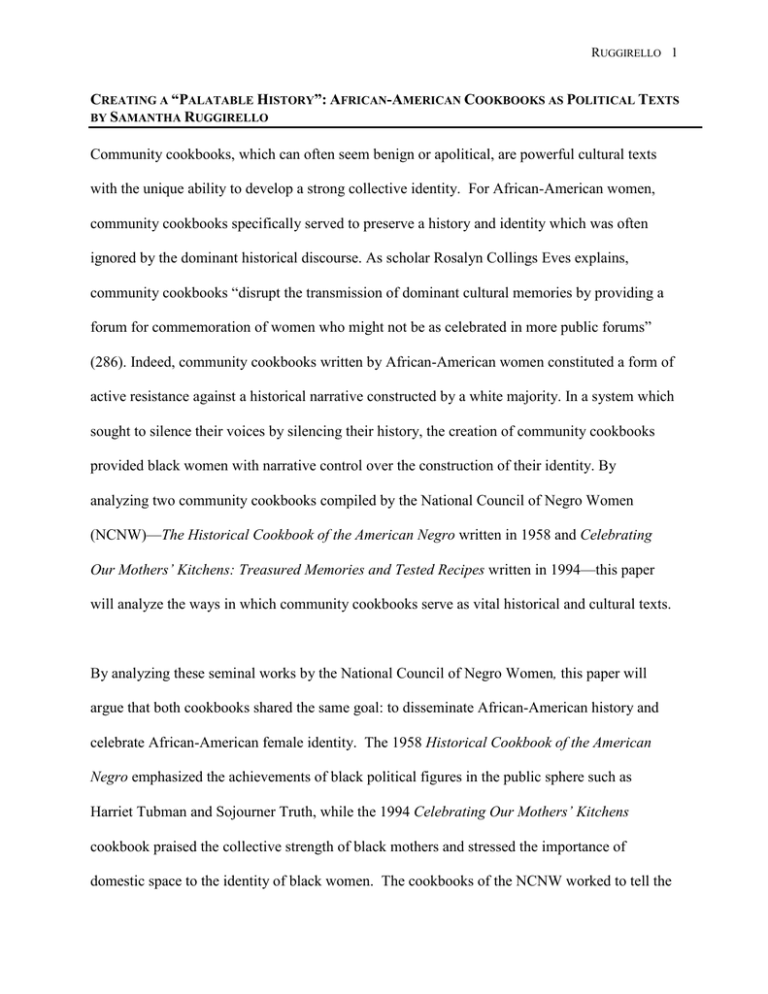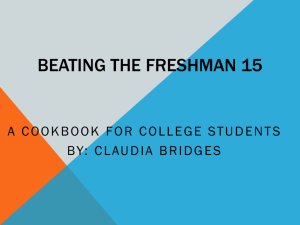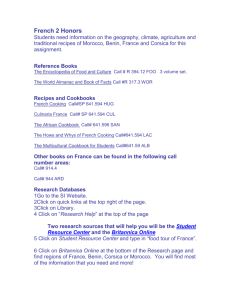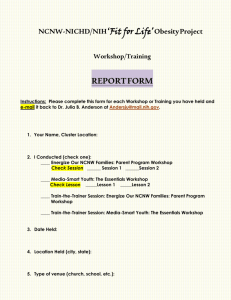“P ”: C H
advertisement

RUGGIRELLO 1 CREATING A “PALATABLE HISTORY”: AFRICAN-AMERICAN COOKBOOKS AS POLITICAL TEXTS BY SAMANTHA RUGGIRELLO Community cookbooks, which can often seem benign or apolitical, are powerful cultural texts with the unique ability to develop a strong collective identity. For African-American women, community cookbooks specifically served to preserve a history and identity which was often ignored by the dominant historical discourse. As scholar Rosalyn Collings Eves explains, community cookbooks “disrupt the transmission of dominant cultural memories by providing a forum for commemoration of women who might not be as celebrated in more public forums” (286). Indeed, community cookbooks written by African-American women constituted a form of active resistance against a historical narrative constructed by a white majority. In a system which sought to silence their voices by silencing their history, the creation of community cookbooks provided black women with narrative control over the construction of their identity. By analyzing two community cookbooks compiled by the National Council of Negro Women (NCNW)—The Historical Cookbook of the American Negro written in 1958 and Celebrating Our Mothers’ Kitchens: Treasured Memories and Tested Recipes written in 1994—this paper will analyze the ways in which community cookbooks serve as vital historical and cultural texts. By analyzing these seminal works by the National Council of Negro Women, this paper will argue that both cookbooks shared the same goal: to disseminate African-American history and celebrate African-American female identity. The 1958 Historical Cookbook of the American Negro emphasized the achievements of black political figures in the public sphere such as Harriet Tubman and Sojourner Truth, while the 1994 Celebrating Our Mothers’ Kitchens cookbook praised the collective strength of black mothers and stressed the importance of domestic space to the identity of black women. The cookbooks of the NCNW worked to tell the RUGGIRELLO 2 stories of African Americans because in the mainstream historical record, the complex history of African Americans was often glossed over, or omitted entirely. In history books, classrooms, and public discussions, the accomplishments and contributions of African Americans were, and continue to be, ignored in order to construct a historical record that supports the continued subjugation of people of color. The absence of African-American historical actors and a meaningful education on black history perpetuated the idea that African-Americans had no “worth-while past” (Woodson 185). By stripping African-Americans of their history and their sense of identity, mainstream education in America served as a hegemonic power, justifying “slavery, peonage, segregation, and lynching” and teaching African-Americans to essentially subordinate themselves. (Woodson 7). Community cookbooks by the National Council of Negro Women worked against this biased presentation of United States history that erased and diminished the role of African Americans. The history of African-American women has especially suffered due to the Anglo-centric historical discourse. Even though black women‟s history has become a subject of interest in recent years, the lack of archival information regarding black women makes research on their lives a difficult feat. Scholar Linda J. Henry explains that “even institutions devoted to documenting black culture have often overlooked black women” (Henry 251). In the rare moments when African-American women were included in historical discussions, they often served to reinforce stereotypes and to support the dominant cultural ideology. Patricia Hill Collins asserts that both the historical record and present day discourse portray AfricanAmerican women as “stupid; having an „essential animal-like sexuality, a „natural‟ willingness to RUGGIRELLO 3 serve, and an „innate; ability to cook” (8-9). It was these racist notions that inspired the cookbooks written by the National Council of Negro Women. A HISTORY OF THE NATIONAL COUNCIL OF NEGRO WOMEN The National Council of Negro Women (NCNW) was founded by Mary McLeod Bethune in 1935 in New York City. Originally, the council consisted of Bethune and twenty-nine representatives from other black women‟s organizations whose goal was to combat racial oppression (Henry 251). They sought to “educate, encourage, and effect the participation of Negro women in civic, political, economic, and educational activities and institutions” (Bower, 154). By the 1950s, the organization had embarked on various projects to fight for fair labor practices, improve health care for African-Americans, and fight for civil rights. They began publishing the AfraAmerican Women’s Journal in the 1940s, which later became Women United, and even supported the formation of the United Nations (Bower 154). Besides their many civic projects, they were dedicated to preserving and sharing African-American history. Shortly after Bethune established the NCNW, she created an archives committee charged with collecting documents on the history of black women. The NCNW recognized the importance of archival information in cataloguing and sharing the rich history of African-American women. Mary Ritter Beard, member of the World Center for Women‟s Archives, explained: “Papers. Records. These we must have. Without documents; no history. Without history; no memory. Without memory; no greatness. Without greatness; no development among women” (Henry 252). In order to counter a dominant historical narrative that sought to make African-American RUGGIRELLO 4 women seem like passive participants in American history, the NCNW needed documentation to assert their place. One of these archival projects was a cookbook. In 1958, the National Council of Negro women collected recipes from its members and compiled a community cookbook entitled, The Historical Cookbook of the American Negro. The book was part cookbook and part black history textbook that resonated with the African-American community on many levels. Following the success of The Historical Cookbook of the American Negro, the NCNW published four more cookbooks beginning in 1991. These cookbooks include The Black Family Reunion Cookbook (1991), The Black Family Dinner Quilt Cookbook (1993), Celebrating Our Mothers’ Kitchens (1994), and Mother Africa’s Table (1998) (Bower, 154). The cookbooks all vary in terms of focus, yet share the same mission: to transmit African-American history and culture through the subject of food. The women of the NCNW recognized the value of community cookbooks and food, using it as a vehicle to document their history and take an active role in shaping African-American identity. The fact that the NCNW chose community cookbooks as their method for sharing black history speaks to the value of community cookbooks as cultural and political texts. Reading community cookbooks is akin to looking at a snapshot of a moment in history. By analyzing the content, publishing history, and authorship of a cookbook, readers can gain an understanding of the women who wrote them. For example, women submitting recipes using their husbands‟ names (i.e. Mrs. John Smith), might indicate that women of the time period had limited social power outside of their husbands. Cookbooks with local or immigrant recipes can also highlight certain foods and foodways important to a community. RUGGIRELLO 5 Community cookbooks are valuable political texts because they build collectivity and community in spaces where they may not have previously existed. Community cookbooks written by women, as most are, specifically facilitate “a politics of celebrating women getting together, creating collectively, feeding and nurturing others, valuing women and women‟s work” (Ferguson 696). Community cookbooks like those written by the NCNW create a space for women to share their unique experiences as women. In a cultural climate which devalues women‟s stories and women‟s work, community cookbooks are a space where women‟s knowledge is valued. By contributing and sharing food knowledge with other women, community cookbook authors are engaging in complex systems of community building. In the case of the National Council of Negro Women, cookbooks fostered an African-American community which “valorizes families (especially mothers), education, hard work, and religious belief” (Collings Eves 285). By engaging in the process of creating a community cookbook, the women of the NCNW claimed ownership over their domestic roles and created a space to express their collective identity. In this way, community cookbooks produced by the NCNW legitimated African-American women‟s history and exposed readers to the perspectives generally overlooked by mainstream media. DEPICTIONS OF BLACK STRENGTH IN THE HISTORICAL COOKBOOKS OF THE AMERICAN NEGRO The Historical Cookbook of the American Negro presented the history and identity of AfricanAmerican women in a revolutionary way. Sue Bailey Thurman, the book‟s editor, chose to structure the book according to the calendar year. Each month or holiday was accompanied by historical information about prominent African-American figures, organizations, and holidays. RUGGIRELLO 6 For example, the book‟s recipe for “New England Clam Chowder” is not located in the section dedicated to soup, but the section on July 18th alongside information about the AfricanAmerican 54th Massachusetts Regiment. This “culinary approach to Negro history,” connected food to culture, and placed African-American history at the forefront (Bower 153). Recipes for this cookbook were acquired by searching “hidden treasures” and looking “into attics and basements; into boxes and chests, pulling out old relics of social, economic and political history, affecting a family, a nation or a people” (Thurman). Using food, and food history as a vehicle, the NCNW filled a gap in the historical record with their own stories and voices. The Historical Cookbook of the American Negro achieved this goal by highlighting integral African-American figures, organizations, traditions, and holidays. According to Mary McLeod Bethune, the people and holidays that were featured in the cookbook were “selected as symbols of the past who sought only to preserve the life of the future, knowing that the future must be guaranteed in the present” (Historical Cookbook foreword). The book, for instance, includes a picture of Sojourner Truth, African-American abolitionist and women‟s rights advocate (Historical Cookbook 1). The book honors Sojourner Truth with recipes for “Hot Chicken Salad,” “The Wandering Pilgrim‟s Stew,” and a meal ambiguously titled “Rocks” (Historical Cookbook 113). It honors Harriet Tubman in a variety of ways as well, including a quilt depicting her face made by the California Quilt Society, a photograph of the S.S. Harriet Tubman, and even a short passage written by Honorary President of the NCNW, Vivian Carter Mason who knew Tubman (Historical Cookbook 146, 50, 28). The cookbook also honors Frederick Douglass, George Washington Carver, Booker T. Washington, and Dred Scott. Featuring recipes on the first page of the book for “Emancipation Proclamation Breakfast Cake” RUGGIRELLO 7 would have further reminded readers of the role that black figures played in the construction of history. By celebrating both African-American food and historical figures, the NCNW reminded readers of the vital role that African Americans played in the historical trajectory of the United States. In addition to heroic freedom leaders and slave rebels, this cookbook also honors black authors, founders of African-American sororities, musicians, entrepreneurs, and council members from across the nation. The cookbook is not limited to African-Americans either. For example, the cookbook celebrates George Washington, “the father of our country,” with a recipe for “Cherry Torte Ice Cream” (Historical Cookbook 21). The July section contains a photograph of a plaque honoring Colonel Robert Gould Shaw, a white Union officer who famously led the 54th Massachusetts Regiment of black soldiers. The wide variety of figures in this cookbook not only allows the NCNW to highlight important African-Americans, but also white Americans who contributed to Black history and civil rights. The Historical Cookbook of the American Negro, as a result, represents a more inclusive version of history. In countering the dominant discourse that only highlighted the achievements of white men, the NCNW presented a more diversified set of historical figures. By specifically including white figures who worked alongside AfricanAmericans in their fight for liberation, the NCNW illustrated the ways that white Americans could be allies. The cookbook not only showcased both white and African-American figures, but also figures and organizations on a global scale. In an act of international solidarity, the cookbook includes a section for United Nations Day Celebrations with recipes honoring both Ghana and Haiti‟s RUGGIRELLO 8 Independence Day (Historical Cookbook 97, 102). These recipes are significant because they reinforce the integral role that the NCNW played in the formation of the United Nations. In fact, there was even a NCNW official observer at all U.N. proceedings (Historical Cookbook xiii). International recipes in this cookbook, as a result, represent the African-American community‟s support for justice in global struggles. The variety of figures, nations, and holidays honored in the cookbook highlights the diversity of the African-American experience. The variety of recipes in the cookbook also showcased the diversity of African-American food. Although African-American food is often associated with soul food, the recipes featured in the cookbook are not limited to this particular cuisine. There is an eclectic mix of recipes throughout the cookbook, including pecan pie, which is representative of southern-American cuisine more broadly. Other recipes such as “Rice and Beans” and “Veal Steak Paprika” illustrate the expansiveness of the African-American culinary experience. By featuring a wide variety of recipes, the NCNW was both fulfilling and dispelling stereotypes of “black” food. The NCNW presented a complex view of “black” food that served to “play up and against prevalent notions of what “Black” food is (and is not)” (Zafar 453). The inclusion of eclectic recipes provides an important lesson for its readers: “Don‟t stereotype black women, don‟t stereotype black history, and don‟t stereotype black food” (Bower 161). DEPICTION OF BLACK MOTHERHOOD IN CELEBRATING OUR MOTHERS’ KITCHENS Celebrating Our Mothers’ Kitchens takes a slightly different approach to celebrating black history. While The Historical Cookbook of the American Negro was reacting to the absence of the African-American voice in history, Celebrating Our Mothers’ Kitchens responded more to the “actual and perceived social threats to family” (Bower 166). Throughout the book, there are RUGGIRELLO 9 multiple allusions to changes in the family structure over time. For example, the book‟s editorial consultant, Jessica B. Harris, states in the prologue of the book: The family experience of mealtime is disappearing under the weight of multiple mealtimes. Today‟s family rarely sits down together. Cramped spaces of yesterday‟s kitchen table are being replaced by trays in another room in front of blaring television sets that halt all mealtime exchanges…These trappings of modern life should not allow us to lose the amazing nurturing power of mealtime communion. (6) The book tackles these “perceived social threats to family” by evoking themes of nurturing and motherhood that honored black mothers and the domestic spaces in which they worked (Our Mothers' Kitchens 4). In the prologue, Harris speaks of mothers as “emblematic.” She writes that “Mama in the kitchen” calls to mind images of “helping hands still floured with biscuit dough, tousled hair disarranged by steam, and slightly damp faces that radiate the heat of the stove back with the additional warmth from that invisible ingredient known as love” (Our Mothers’ Kitchens 5). Harris‟ words portray “Mama” as an overarching American figure, representing comfort, home, and family. In response to a culture of eating dinner in front of the television set, the NCNW‟s universal “Mama” reminds readers of family values and the sanctity of the kitchen as a domestic space. The portrayal of black motherhood and its ties to domestic space also serve to dispel stereotypes since black female cooks have historically been stereotyped as “turbaned mammies” and “voodoo magicians” who “ruled the back rooms with simpleminded power” (Zafar 449). The romanticized image of the African-American mother and the kitchen presented by Celebrating Our Mothers' Kitchens attempts to replace this buffoonish caricature with a more accurate RUGGIRELLO 10 representation of what black motherhood meant to them. Through recipes, quotes, and anecdotes included in this cookbook, the NCNW combats the dominant discourse and illustrates how black mothers throughout history ruled from their “kitchen kingdoms,” and “dispensed their knowledge of the world, their strategies for survival, and their hopes for the future” (Our Mothers' Kitchens 5). Although this cookbook follows a more traditional format than The Historical Cookbook of the American Negro by showing a table of contents and sections divided by recipe type, Celebrating Our Mothers' Kitchens also uses food in creative ways to convey black history. On the bottom of every cookbook page stands a saying or phrase from the mother of an NCNW member. Each saying follows the same format by beginning with “My mother (insert name) said” and then continuing with a saying or piece of advice. For instance, under the recipe for “Rosie‟s Best Creole Gumbo,” readers see a piece of advice from the mother of Rosa Parks, which says “My Mother Leona Edwards McCauley said… when I had a difficult task my mother would gently say, „Keep inching along like a poor inch worm. You will get there and by.‟ (Our Mothers' Kitchens 10). In this context, cookbook recipes and motherly wisdom are intertwined, representing a piece of family history. Celebrating Our Mothers’ Kitchens promotes an appreciation for family life and black mothers in the domestic space. Although the repeated theme of “kitchen mothers” may seem oppositional to the strong and fearless African-American women presented in The Historical Cookbook of the American Negro, the NCNW is making a powerful statement by reclaiming the domestic space for black women in their own homes, and in their own kitchens—spaces which RUGGIRELLO 11 were historically denied to them as domestic workers. Rather than being tied to the kitchen due to a legacy of slavery and racism, the mothers in this cookbook are actively choosing to occupy the domestic space, and use this space as a place to pass down their own histories. Like The Historical Cookbook of the American Negro, this cookbook also moves beyond stereotypes of “black food” by containing a wide variety of recipes. Traditional southern recipes such as pickled okra, oxtail soup, and fried catfish are interspersed between recipes for enchilada pie casserole, shrimp balls, and Spanish liver that originate from a wide array of cultures. While recipes for traditionally southern foods like okra and fried catfish acknowledge the women‟s historical connection to soul food, the wide variety of recipes also sent a clear message that the black experience in the United States is diverse and representative in meals and recipes beyond soul food. DIVERGENCES BETWEEN THE TWO COOKBOOKS While both The Historical Cookbook of the American Negro and Celebrating Our Mothers' Kitchens attempt to provide a cohesive view of black history, their goals and methodologies obviously differed. The Historical Cookbook of the American Negro focused primarily on African-American public and political figures to correct the omission of black men and women from American history. Figures like Sojourner Truth and Harriet Tubman are memorialized in this cookbook to demonstrate that there is a place for black women both in the public forum and in the historical record. Although Celebrating Our Mothers' Kitchens also contains references to black public figures such as Rosa Parks, Patti Labelle, and Coretta Scott King, the focus is shifted to the authors‟ mothers. With various quotes, anecdotes, and recipes in the cookbook from the cookbook authors‟ mothers, Celebrating Our Mothers' Kitchens serves to legitimate RUGGIRELLO 12 “women‟s work,” reclaim the domestic space, and emphasize the strength of black mothers. As a result, The Historical Cookbook of the American Negro demonstrated the important role of African-American women in the public sphere, while Celebrating Our Mothers' Kitchens illustrated the equally important role of African-American women in the domestic sphere. These two constructions of black womanhood look so differently because they were written at two different moments in history. When The Historical Cookbook of the American Negro was published in 1958, African-Americans were still denied many of the basic civil rights afforded to white Americans. As discussed previously, African-American history was virtually non-existent in the public consciousness. The NCNW emphasized the professional achievements of the African-American community in order to counter this dominant cultural memory that ignored their achievements. The goal was to prove that there was a space for African Americans outside the role of servant and maid in the home. Celebrating Our Mothers' Kitchens took a different approach to black womanhood because the historical context necessitated it. As more and more African-American were entering the public sphere and holding positions of power, the onus was no longer on the National Council of Negro Women to prove that women had a role in the professional sphere but to emphasize the legitimacy of black women‟s roles inside the home. Sensing a threat to family life, and the need for “preserving [their] history of accomplishment against the odds,” the NCNW celebrated “kitchen mothers” and the domestic space (Our Mother’s Kitchens 213). CONCLUSION Community cookbooks by the National Council of Negro Women, therefore, demonstrate how food and recipes can be powerful tools for identity construction. By working together to share RUGGIRELLO 13 histories, recipes, and identities, the women of the NCNW were able to preserve AfricanAmerican history, disseminate historical knowledge, and take an active role in shaping their identity despite a dominant cultural narrative that sought to silence them. Further investigation on this topic should be directed to the three other cookbooks published by the NCNW, which might also yield insight into how African-American authors used food and cookbooks to resist mainstream discourses. The interpretive possibilities of these cookbooks are clear after analyzing The Historical Cookbook of the American Negro and Celebrating Our Mothers' Kitchens. Community cookbooks by the NCNW, in sum, reveal how food literature can be a vital form of resistance by transmitting historical knowledge and cultural values that might otherwise be silenced. RUGGIRELLO 14 WORKS CITED Primary Sources National Council of Negro Women. Celebrating Our Mothers' Kitchens: Treasured Memories and Tested Recipes. Memphis: The Wimmer Companies, Inc., 1994. Print National Council of Negro Women. The Historical Cookbook of the American Negro. Ed. Sue Bailey Thurman. 1958. Reprint. Boston: Beacon, 2000. Print. Secondary Sources Bower, Anne. "Recipes for History: The National Council of Negro Women's Five Historical Cookbooks." African-American Foodways: Explorations of History and Culture. Urbana: University of Illinois, 2007. 153-75. Print. Collings Eves, Rosalyn. "A Recipe for Remembrance: Memory and Identity in African American Women's Cookbooks." Rhetoric Review 24.3 (2005): 280-297. JSTOR. Web. 5 Oct. 2013. Collins, Patricia Hill. Fighting words: Black women and the Search for Justice. Minneapolis: University of Minnesota Press, 1998. Print. Ferguson, Kennan. "Intensifying Taste, Intensifying Identity: Collectivity through Community Cookbooks." Signs 37.3 (2012): 695-717. JSTOR. Web. 5 Oct. 2013 Henry, Linda J. "Promoting Historical Consciousness: The Early Archives Committee of the National Council of Negro Women." Signs: Journal of Women in Culture and Society 7.1 (1981): 251-59. JSTOR. Web. 5 Oct. 2013. Woodson, Carter Godwin. The Mis-education of the Negro. Trenton, NJ: Africa World, 1990. Print. RUGGIRELLO 15 Zafar, Rafia. "The Signifying Dish: Autobiography and History in Two Black Women's Cookbooks." Feminist Studies 25.2 (1999): 449-69. JSTOR. Web. 15 Jan. 2014.


